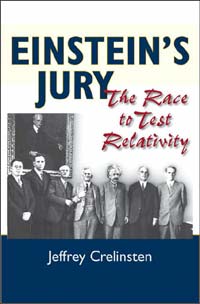Review: Einstein’s Juryby Jeff Foust
|
| Even after the 1919 Eddington expedition many astronomers sought additional evidence, and some physicists remained unconvinced that relativity was correct. |
The first efforts to confirm one of the central tenets of general relativity—the gravitational bending of light—actually date back to before Einstein completed his theory in 1916: he predicted the phenomenon in a 1911 paper. Astronomers who were already observing solar eclipses in a search for a putative inner planet that could explain the precession of Mercury’s orbit (something eventually explained by general relativity) also used those expeditions to look for deviations in the positions of stars in the vicinity of the eclipsed Sun. Several efforts prior to Arthur Eddington’s 1919 expedition off the coast of Africa to measure any deflection failed for reasons ranging from poor weather to the onset of the First World War.
While that conventionally is the end of the story in the quest to prove general relativity, Einstein’s Jury demonstrates that the effort to confirm the theory was just beginning. Even after the Eddington expedition many astronomers sought additional evidence, and some physicists remained unconvinced that relativity was correct. Only by the late 1920s and early 1930s, after several other efforts turned up evidence that supported general relativity did the theory have the consensus of the physics community. Crelinsten discusses these efforts in great detail, explaining how the theory gradually gained acceptance in the physics community.
The book puts the attempt to confirm general relativity into the broader context of physics at the turn of the 20th century. At that time the “big four” in physics in astronomy were Germany, France, the UK, and the US, but their strengths were different: Germany was a hotbed for theoretical physics, while there was more work on experimental physics and astronomy in the UK and US, especially as state-of-the-art observatories were built in California around the turn of the century. These different strengths meant physicists in these countries approached relativity in different ways: while some European physicists delved into the theoretical ramifications of relativity long before it was proven, their American counterparts waited until there was sufficient proof it was correct before exploring its cosmological and other implications.
As Crelinsten notes, “relativity, despite its popularity today, is still not part of the general culture”. In other words, while many use the results of relativity on a regular basis, few people spend time thinking about relativity itself and what it means for the universe and our place in it. “It will take a few deep thinkers who can also communicate in a powerful and meaningful way to bring Einstein’s ideas into our general consciousness. They will need to make relativity relevant to us.” Einstein’s Jury is not that book, but it does a fine job explaining the effort involved in finding evidence for relativity, and why it continues to be a topic of interest even today.
